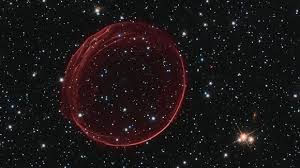COMPLEX TIME: THE HIDDEN SIDE OF REALITY
- planck
- Aug 28
- 6 min read
"It's not that the Universe is stranger than we imagine, it's that it's stranger than we can imagine." Werner Heisenberg
Probably the best-selling popular science book in history is Stephen Hawking's "A Brief History of Time" has sold approximately 10 million copies worldwide. In this book, Hawking mentions a rather exotic concept that has probably surprised the vast majority of his readers: the concept of complex time or imaginary time. This "strange" concept has proven very useful in solving certain problems in fundamental physics and is one of the key ideas for understanding the so-called Hartle-Hawking state, which is the most promising proposal for describing the quantum creation of the Universe. In this article, we will try to explain step by step what imaginary time consists of, its surprising consequences, and its possible role in the beginning of our Universe.
Imaginary time and the quantum tunneling effect
Next, we'll look at one of the strangest and most counterintuitive phenomena in quantum mechanics. Consider a particle (e.g., a photon) that lies in the first valley (point -a) of the so-called double Bell potential (a quadratic potential of the form x 4 - 2x 2 + 1 ):

According to classical mechanics, it is impossible for a particle to reach point "a" if it does not have enough energy to overcome the central potential barrier. Therefore, in the absence of the necessary energy, the particle will remain forever confined in the potential well. However, quantum mechanics tells us something that seems incredible: there is a non-zero probability that the particle will "spontaneously" jump from the minimum "-a" to the minimum "a." How is this possible? This phenomenon is called "quantum tunneling."

Let's analyze the dynamics of our particle confined at the bottom of the potential well. Using the formalism of quantum mechanics, we can calculate the difference between the energy level of the ground state (vacuum state) and the first allowed energy level of the particle. This energy is on the order of:

Where A is a constant and g is a parameter that depends on the depth of the potential well. This value constitutes the minimum amount of energy needed to make the particle "jump" from the vacuum state to another energy state. Following the quantum mechanical formulation of Feynman path integrals, the probability that a particle at the minimum "-a" will propagate to the minimum "a" is:

The action S[x] is the difference between the kinetic energy and the potential energy. For our previous potential well, we have:

And the equation of motion (Euler-Lagrange equation) is therefore:

But now we run into a seemingly insurmountable problem: this equation has no real solutions (since we are taking the square root of a negative number) and produces a divergent path integral. Furthermore, the action is imaginary, since the minimum-energy solution (minimum action) that makes the particle "jump" must satisfy the following conditions:

And therefore we have that iS/h=- A / g 2 h or iS=-A/ g 2 and therefore the associated action is purely imaginary. This poses a serious problem because we cannot resolve the propagator between -a and +a.
This is where mathematics begins to show its "magic": if we look at the action or the equation of motion, we find that all our problems stem from the negative sign. In fact, if we could invert the potential, we would get:

And then the potential barrier would disappear and we would have a path of zero energy (and minimum action) that directly connects the points -aya!
The action of this inverted potential would be:

And the equation of motion would be:

These are the same equations as in the previous case but with the sign changed!
The question is: Analyzing the symmetries of the system, can we make a change in the variables involved so that the original solution is equivalent to that of the inverted potential? The answer is yes, but the change involves using imaginary time. The change we must make is to replace (t) with (-it), which implies that the action (S) becomes (iS). Now, our minimal action becomes real and solvable:
S= A/ g 2h
The solution to the equation of motion is:

These solutions are called instantons and, as we will see, they have amazing characteristics.
Instants, complex time and the hidden side of reality
Instantons are solutions to the equations of motion and owe their name to the fact that they are located at an instant in time, meaning the "jump" occurs in a very short period of time. In fact, some experiments suggest that the "real" time elapsed inside the barrier is zero.
But what physical meaning can this complex time have? Like explorers of a new and unknown world, physicists have recently ventured to discover its secrets. To explore this hidden world, physicists have utilized recent advances in the understanding of how to "complexify" functional integrals and advances in the so-called resurgence theory. The key idea is to use a complex action with a real part and an imaginary part instead of using a purely real or purely imaginary action. The change that must be made is the following:

The alpha parameter acts as a "controller" so that for alpha = 0 we have our purely real action, and for alpha = PI/2 we have the purely imaginary action. With this change, the action is:

Therefore the equation of motion is:

And the solution to the equation of motion is therefore:

For our modification of the action to be valid, a "complexification" of space-time must be performed using recently developed mathematical techniques. Once this "complexification" is complete, the "explorers" begin to see a new world, a "hidden reality":

The first image shows the "complexified" space for alpha = PI/2, which corresponds to our usual Euclidean instanton, in which we only see the real part (the points -a and +a represented as -1 and +1), and the imaginary part is zero. The second image corresponds to alpha = PI/4, in which a "twist" begins to be seen through the imaginary component. The third image corresponds to alpha = PI/8, in which the oscillation in the imaginary part begins to be seen more clearly. The key point is the following: as we decrease alpha and therefore go from a purely imaginary instanton to a real one, we observe that what in our "real" world is a discontinuous jump is actually a continuous path through complex space-time . This is the hidden reality that we can only access with the power of Mathematics!
What happens if we continue to lower the alpha value? For alpha = 0.04PI/2, the result is as follows:

As we approach alpha = 0, the value begins to oscillate more and more rapidly around the "real" points -a and -a. Thus, for alpha = 0.001PI/2, we obtain:

Now the oscillation is so violent that it seems to fill the entire complex space-time around the points -a and -a!
The physical interpretation of these results is still unclear. It appears that complex time is linked to quantum tunneling processes and quantum randomness.
Finally, we will briefly analyze the role that instantons could have played in the creation of our Universe.
Imaginary time and the beginning of space-time
Cosmological observations indicate that our early Universe was homogeneous and isotropic and was therefore described by the famous FLRW metric.
In time the action is given by:

Where a' and X' are the derivatives of the scale factor of the Universe and the value of a scalar field respectively with respect to conformal time. The so-called restriction of the Hamiltonian implies that the total Hamiltonian is zero:

Where we have:

This expression tells us something fundamental, the sum of the Hamiltonians associated with the matter fields Hx and the space-time itself Ha is zero:

Where:

The first expression corresponds to a harmonic oscillator whose solution is:

The second expression is a solution anharmonic oscillator:

The potential that appears in this last expression is a potential associated with space-time itself . The key point is that this potential divides space-time into three distinct zones:

Zones I and III are described by the usual Lorentzian metric with real time. However, Zone II represents a potential barrier. Inside Zone II, spacetime is Euclidean and time is imaginary. A particle with energy less than 4H2C (C=2epsilon) will not have enough energy to cross the potential barrier, but it will be able to do so through quantum tunneling . This is where we come to our key point: our early pre-inflationary Universe with zero total energy may have emerged through an instanton that allowed it to "cross" the Euclidean spacetime barrier at the origin of the Universe (see this article ).
This state is known as the Hartle-Hawking state. In fact, solutions to the so-called Wheeler-DeWitt equation allow the "jump" from an eternally cyclical Universe to an expanding Universe like ours:

So, do we owe our existence, and that of our entire Universe, to the effect of primordial instantons? Is our Universe really a Multiverse or a Universe formed from a cyclical space-time continually creating new Universes? The answer may be hidden in the concept of complex time.
Sources:
Real-Time Feynman Path Integral Realization of Instantons , Quantum cosmology of a conformal multiverse











Comments